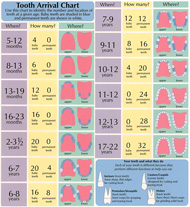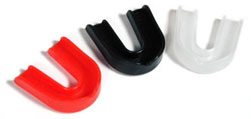
- Early infant oral care
- Fluoride treatment
- Sealants
- Dental Radiographs
- Restorations
- Children’s pulpotomy (Root canal) and crowns
- N20 (Laughing Gas)
- Conscious sedation
- Hospital Dentistry
- Interceptive Orthodontics
- Mouthguard and night guard
Early Infant Oral Care
It is very important to maintain the health of baby teeth. In order to prevent dental problems, your child should see a Pediatric dentist no later then his/her first birthday. Pediatric dentist has 2-3 years specialty training following dental school and they are primary oral care providers for infants, children through adolescence, and children with special needs.
Tooth Development Chart

click chart to view full size
Fluoride Treatment
Fluoride should be used in small amount on a routine basis, and it helps to prevent cavities. Fluoride facilitates “Remineralization” which helps the strengthening of weak areas on teeth. Fluoride is documented to be safe and highly effective. Fluoride is in dental products such as toothpaste, mouth rinse, gels, varnish, and supplements. Children under the age of 3 may not be able to spit out the toothpaste and as a result they digest the fluoride. In this age group non fluoridated toothpaste or training toothpaste should be used, until the child is able to spit out the toothpaste.
Dental Sealants
A dental sealant is a protective, plastic coating applied to the chewing surface of the teeth. Sealants should be applied to the permanent teeth as they erupt to prevent cavities.

Dental Radiographs
Many diseases, lesions and conditions can only be detected with the use of dental radiographs. It is impossible to see directly between the teeth without dental radiographs. Radiographs may be needed to survey erupting teeth, diagnose bone disease, cavities, evaluate an injury or plan orthodontic treatment. The amount of radiation received in a dental radiograph examination is very small. Lead body uniform and shields will protect your child. In our facility we use digital radiograph.
Restorations
Tooth colored fillings are used to restore front or back teeth or where cosmetic appearance is important. Tooth colored fillings are used to repair fractured teeth and/or areas of decay.
Children’s Pulpotomy (root canal) and Crowns
Pulp therapy is the treatment of infected nerves and blood vessels inside of each tooth. When a cavity is very deep it irritates the pulp tissue and causes pain, discomfort and as it progresses it becomes an abscess and infection. A crown is necessary when there is extensive decay, or loss of tooth structure due to trauma, or a tooth with pulpotomy. For front teeth a composite (white) crown is used to match the color and for the back tooth a stainless steel crown is used. The crowns do not contain mercury.
N2O (Laughing Gas)
N2O/O2 is a blend of 2 gases oxygen and nitrous. N2O increases the pain threshold and decreases the gag reflex and make the dental treatment more pleasant. N2O is very safe, it has a rapid onset, it is reversible, and non allergic. Your child will remain fully conscious during treatment.
Conscious Sedation
Sedation is used to modify a child’s behavior during dental treatment. Sedation may be indicated for children with high levels of anxiety, very young children with extreme dental treatment, and some patients with special needs. Various medications can be used to sedate a child. During the sedation, patient will be monitored the whole time.
Hospital Dentistry
It is a full mouth dental rehabilitation under general anesthesia at the hospital.
Interceptive Orthodontics
It is used to eliminate or reduce the malocclusion in young children. Example of circumstances requiring such intervention would be, thumb sucking and pacifier habit, cross bite, severe crowding, early loss of primary tooth.
Mouth Guard
All sports activities have a risk of oral facial injuries due to balls, collisions, and contact with hard surfaces. A custom made mouth guard is individually designed and constructed in the dental office or laboratory. A custom-made mouth guard fits well and does not interfere with speech or breathing.




